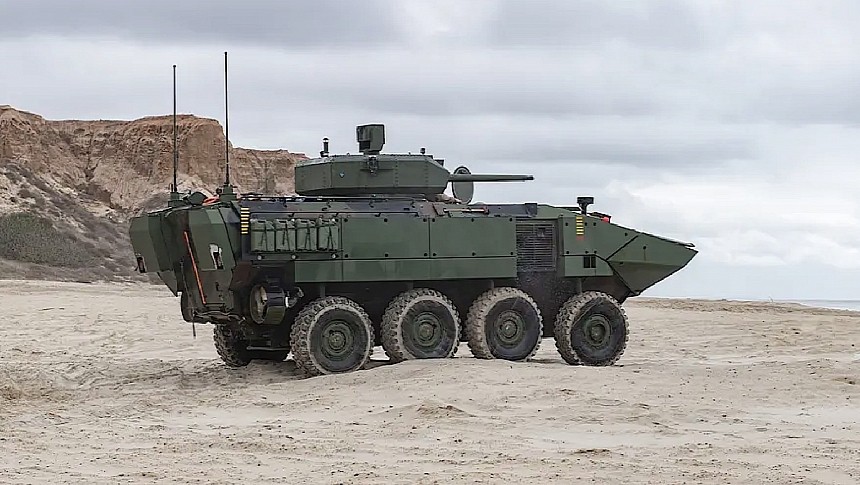Amphibious vehicles are some of the most badass pieces of engineering designed on this Earth. Capable of going both over dry land and open water with equal prowess, they have long ago established themselves as favorite tools of the trade for the world's most powerful militaries.
Almost every single country that has a shoreline and a Navy uses such vehicles. We don't get to see them in action as often as say military aircraft (luckily, as their use usually translates into war), but they are there, always ready to take troops ashore in places the enemy expects them the least.
Over in the U.S., amphibious vehicles do not come in as many shapes and sizes as you'd think. In fact, there is a single kind of such machine currently being produced: something called simply and effectively the Amphibious Combat Vehicle (ACV).
The platform is a product of defense contractor BAE Systems, and it became the focus of the American Marine Corps back in 2018, when it was selected to become the backbone of the military branch's amphibious operations.
That's because the ACV, although technically a land vehicle with eight wheels, can drive through the ocean as well, performing ship-to-objective troop transport. The 35-ton ACV has a maximum range of 325 miles (523 km), and can travel over land at speeds of 65 mph (105 kph). In the water that dramatically drops to just seven mph (11 kph), but it'll get you there.
The last time we heard of the ACV was back in mid-January, when BAE Systems announced the first example of the Command and Control (ACV-C) version of the vehicle was delivered to the Marine Corps.
The ACV family is eventually meant to comprise four versions, two of which are already in service. The first is called Personnel (ACV-P, meant to carry troops), with the second being the aforementioned ACV-C. The final two are the Cannon (ACV-30) and Recovery (ACV-R), which seem to be rapidly catching up.
It's the Cannon that's of interest to us today, as the first production representative test vehicle of the breed was delivered to the Marine Corps for testing.
Just like the other versions, this one too can carry troops to their target, but unlike its siblings it is capable of offering direct fire support to advancing troops. It does that thanks to a stabilized 30 mm remote turret system manufactured by Kongsberg.
The solution was chosen because it "eliminates the space requirement of legacy turreted cannon systems and provides more room to transport troops or mission essential equipment." It also has the advantage of being somewhat lighter than traditional hardware, which is crucial for military equipment of this kind.
It's unclear how long the Marine Corps will take to validate the ACV-30, but chances are they'll be pretty quick about it given the current global turmoil. The fourth variant of the ACV, meant to provide direct field support, maintenance, and recovery, is following close behind.
Over in the U.S., amphibious vehicles do not come in as many shapes and sizes as you'd think. In fact, there is a single kind of such machine currently being produced: something called simply and effectively the Amphibious Combat Vehicle (ACV).
The platform is a product of defense contractor BAE Systems, and it became the focus of the American Marine Corps back in 2018, when it was selected to become the backbone of the military branch's amphibious operations.
That's because the ACV, although technically a land vehicle with eight wheels, can drive through the ocean as well, performing ship-to-objective troop transport. The 35-ton ACV has a maximum range of 325 miles (523 km), and can travel over land at speeds of 65 mph (105 kph). In the water that dramatically drops to just seven mph (11 kph), but it'll get you there.
The last time we heard of the ACV was back in mid-January, when BAE Systems announced the first example of the Command and Control (ACV-C) version of the vehicle was delivered to the Marine Corps.
The ACV family is eventually meant to comprise four versions, two of which are already in service. The first is called Personnel (ACV-P, meant to carry troops), with the second being the aforementioned ACV-C. The final two are the Cannon (ACV-30) and Recovery (ACV-R), which seem to be rapidly catching up.
It's the Cannon that's of interest to us today, as the first production representative test vehicle of the breed was delivered to the Marine Corps for testing.
Just like the other versions, this one too can carry troops to their target, but unlike its siblings it is capable of offering direct fire support to advancing troops. It does that thanks to a stabilized 30 mm remote turret system manufactured by Kongsberg.
The solution was chosen because it "eliminates the space requirement of legacy turreted cannon systems and provides more room to transport troops or mission essential equipment." It also has the advantage of being somewhat lighter than traditional hardware, which is crucial for military equipment of this kind.
It's unclear how long the Marine Corps will take to validate the ACV-30, but chances are they'll be pretty quick about it given the current global turmoil. The fourth variant of the ACV, meant to provide direct field support, maintenance, and recovery, is following close behind.









